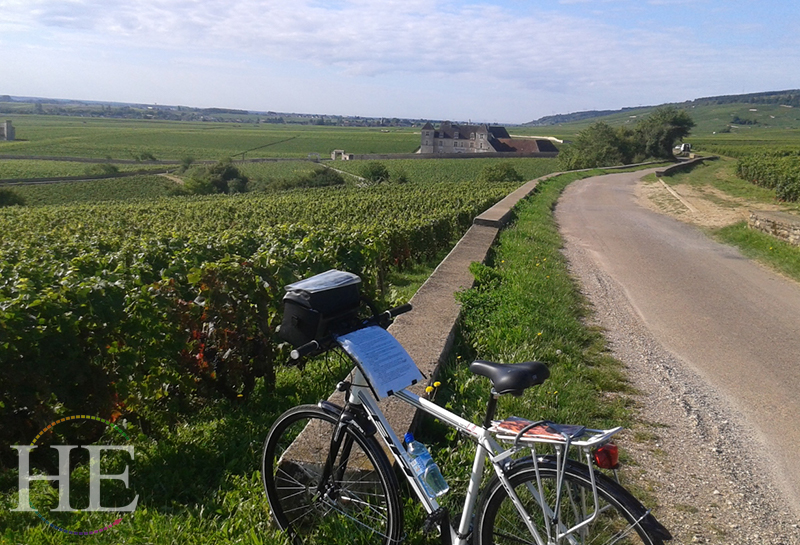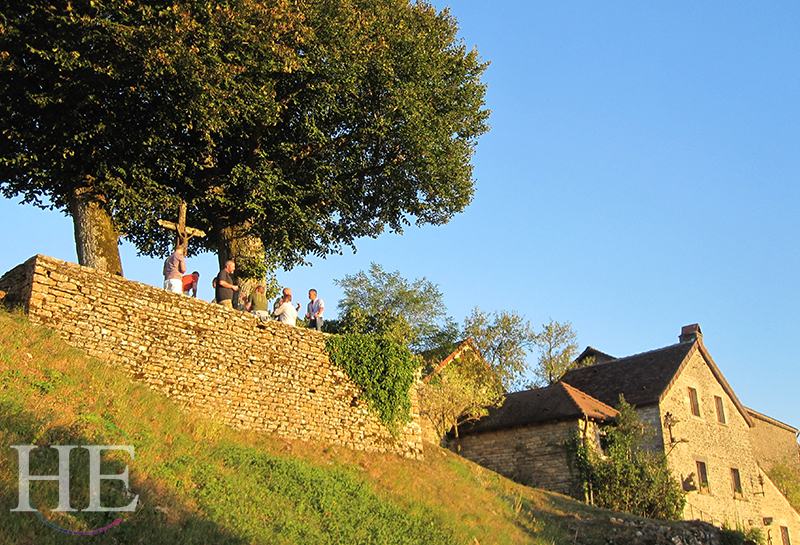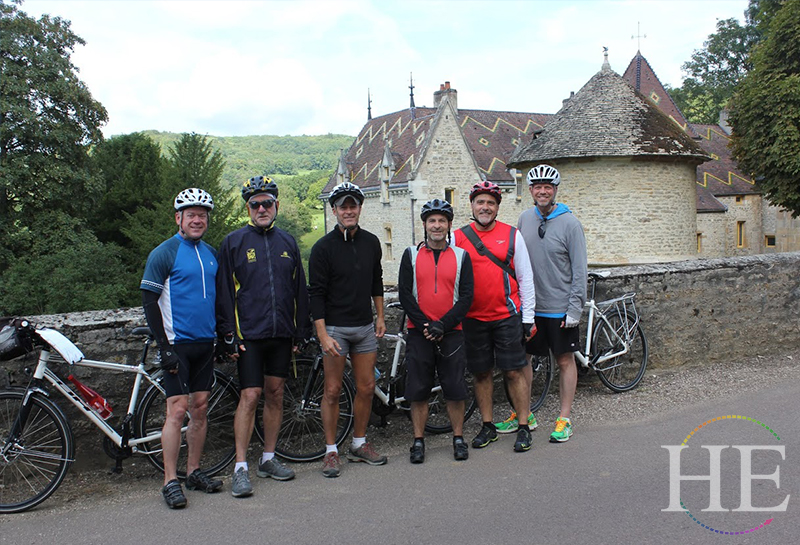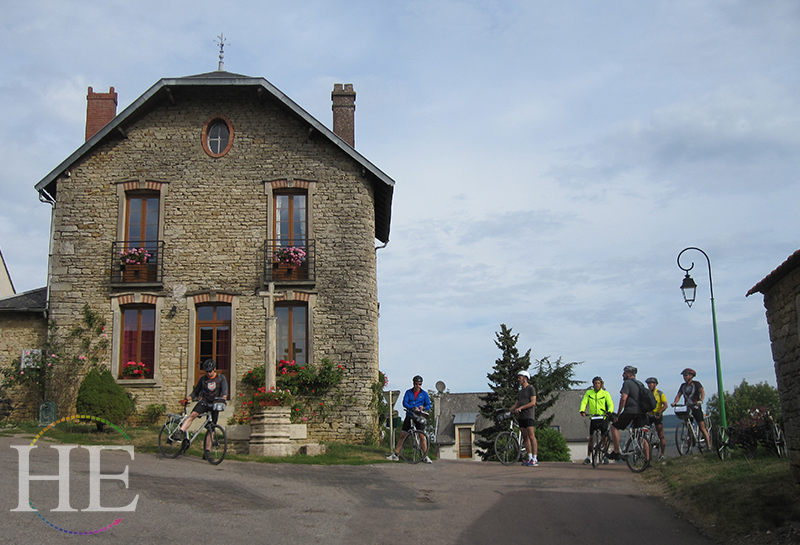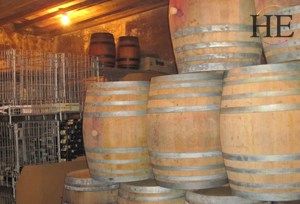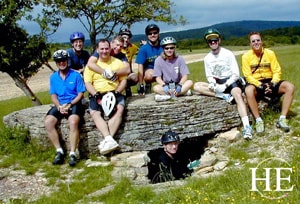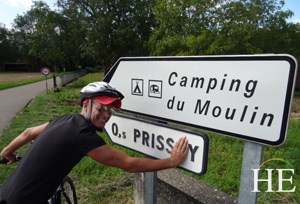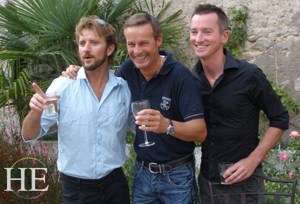Colors of Burgundy Gay Biking Tour in France
A Gay Travel France Bicycle Adventure
Prices listed are per person:
Shared Room: $4298
Private Room: $5198
Cycle through hills and villages rich in history, redolent with the scents of forest and vineyard. Visit Chateauneuf, Roman ruins, medieval towns, and important sites in Catholicism. Burgundy is famed for its food and wine, so dining and wine-tasting will be as much fun as the biking!
Highlights
Roam Beaune’s sprawling Hotel Dieu, a masterpiece of Flemish architecture and the site of a world-famous wine auction.
Follow a quiet, tree-lined trail alongside the locks and barges of the Burgundy Canal.
Step over the Seine River, near its source in the heart of the Bourgognian forest.
Discover the gastronomic delights of a region known for its cheeses, wines, sausages, wild mushrooms, and creative chefs.
Visit the haunting ruins of the 13th-century Abbey of Ste. Marguerite, and the beautifully restored grounds of the abbeys at Fontenay and Bussiere.
Pedal through a quiet village, onto a solitary forest road, then emerge from the trees to see the feudal castle of Chateauneuf looming ahead beyond the pastures.
Explore the old streets of medieval Semur-en-Auxois, perched high over a loop on the Armancon river.
Overview
A gay bike tour through oak forests, fragrant vineyards, and historic sights of Burgundy
Few regions in the world offer such a diversity of natural scenery, fine cuisine, and history as does the ancient kingdom of Burgundy. Join a small, friendly gay bike tour group and pedal through a historic area.
We begin in Beaune, a town dating back to the Caesars. Here, under the arched stone ceiling of a long cellar, sample some of Burgundy’s world-famous wines.
The next day, we bike through vineyards to the wine village of Pommard and an unexpected stop: a stone dolmen(dwelling) dating from the dawn of history, on an out-of-the-way road. Burgundy is filled with such reminders of its long past, many of which don’t appear in guidebooks. Finding such spots is part of what makes this trip an adventure.
In the afternoon, we bike out of a forest to see another historic sight ahead: the feudal castle at Chateauneuf, rising among the cow-filled pastures.
Another day’s biking brings us to the fortified town of Semur-en-Auxois. Perched high on a bend in the Armancon river, this medieval site seems frozen in time. Inside the town walls, cobblestone streets are still lined with tiny bakeries and butcher shops. Burgundy is synonymous with fine red wine, but this evening, as the orange sun sets over the valley, we’ll sit outdoors to sample the white wines of the region as well.
And so the week continues, an invigorating mix of quiet biking roads, villages lost in history, time-outs for hiking and skinny-dipping, encounters with the people of Burgundy, and of course, the food and wine for which Burgundy is known.
Burgundy would be magical under any circumstances. As you’ll discover, the magic is even greater in the company of a lively gay group.
Itinerary
Map:
Join other gay cyclists to travel through a land rich in history, redolent with the scent of forest and vineyards. This biking tour of Burgundy takes us to the feudal castle of Chateauneuf, in an ancient walled town. We’ll visit a seven-century-old abbey long reduced to solitary ruins, and an even older abbey that was recently restored to its former grandeur.
Everywhere, we encounter Burgundy’s long history. Julius Caesar established a settlement here, and as we travel we’ll find ruins from Roman times. Then, as an independent kingdom, Burgundy developed its own distinct culture and became a thriving center of the wine trade. Wine tasting is as popular as biking here, and we’ll get to do both.
This is primarily a biking tour, on a route with plenty of hills, but with many other activities available in between our bike rides. There’s time for hiking, swimming, walking tours along streets that date to the Middle Ages, and, of course, some leisurely and memorable dinners. Burgundy has won fame for both its food and wine and from the flavorful coq au vin to your well-earned dessert, dinner will be as much fun as the biking. We hope you can join us as we admire The Colors of Burgundy.
Day 1: The Color of Burgundy
Beaune settled since Roman times, grew rapidly in the Middle Ages when wine merchants built their cellars here. Much of the ramparts’ wall that protected the medieval town still stands; our afternoon walk for cyclists who arrive early takes us along part of that sturdy wall, which averages 25-30 feet in thickness.
On our walk, we’ll tour the grand Collegiale Notre Dame, a church in the classic Burgundian Romanesque style dating to 1120, as well as a wine cellar that dates back five centuries, where we can sample the wares. Discover the nuanced flavors that have made Burgundy synonymous with fine wine: Aloxe-Corton, Gevrey-Chambertin, Chambolle-Musigny, Clos de Vougeot, Vosne-Romanee, Nuits-Saint-Georges, and Cote de Beaune. Candles allow the connoisseur to evaluate the clarity and ruby hue of each vintage during the wine tasting.
Back at our hotel, we’ll assemble the full group for refreshments and orientation, followed by dinner in a centuries-old dining room. There’s no gay bar in town for after-dinner entertainment, but one benefit of traveling with our groups is that you can always find someone friendly and interesting to join you at a cafe.
Day 2: A Castle on a Hill

This morning’s varied route offers a sense of what’s to come. Our first village is Pommard, a tiny and picturesque village with a growing reputation for fine red wines. Just outside Pommard, in the middle of nowhere, we come upon two artifacts from Roman times: A small bridge built by the Romans; and a nearby dolmen, or primitive dwelling. Duck low and you can go down into this dolmen. Neither of these appears in the usual tourist guides; they’re examples of the unexpected sights that we like to search out for our trips.
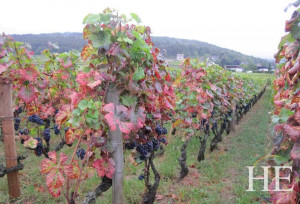
We leave the vineyards and cross into Savigny-les-Beaune, with its moated castle. Now you’ve got a choice: stay on the scenic paved road, or try our more challenging option: an unpaved hiking trail, cutting over a hillside forest to our next stop: the ruins of the Abbey of St. Marguerite.
Standing in a lonely copse, this medieval abbey lost its roof long ago, yet the walls remain, with their arched doorways and windows. This evocative setting is the perfect spot for a picnic lunch.
We search for the true back roads in the regions we visit. After lunch, you’ll discover one of our favorites. If weather conditions allow, we can ignore a “dead-end” sign to glide onto a narrow ribbon of asphalt, winding through orchards, pastures, and forest. You probably won’t see a single car along this stretch — that’s one benefit of knowing when to ignore a dead-end sign!
Whether coming down a long slope on the road or from the hiking path, the road ends at the Burgundy Canal, once a vital commercial link, but now plied by pleasure barges. Stop to watch a barge as it’s lowered through a lock.
Another rural road takes us through a forest and over a hillock. As you emerge from the trees, the feudal town of Chateauneuf appears in the distance like an apparition, rising out of the pastures. By the time you’ve climbed into this tiny and ancient village, you’ll have decided that a 40-mile day wasn’t so short after all. Our guess is that you’ll rank this as one of the best biking days of your life. And you can top it off by wandering through the chateau itself, right outside the doors of our hotel.
Day 3: Fields of Dreams

Today begins with a long, gentle coast from Chateauneuf’s hilltop castle to the Burgundy Canal. From there the route follows miles (well, kilometers) of small paved roads, with almost no traffic. We ride past endless fields of poppies and wheat and through small towns such as St. Sabine, Chazilly, and Cercy, each with its own church and its own charm. On a sunny day, we also have another option: follow the unpaved towpath along the canal. Our hybrid bikes usually have no problem with the occasional patches of gravel, and the pastoral setting brings images of a bygone era.
Finally, the canal disappears underground, a remarkable feat of 19th-century engineering, and we return to the rural roads. But first, we detour to the tiny village of Eguilly, where an energetic Frenchman is devoting his life to renovating the once-grand castle.
After a picnic lunch at the castle, our road skirts rolling fields and honey-colored farmhouses. Eventually, we reach the shorelines of Lac de Pont, a narrow, meandering lake over 3 miles long, but rarely more than a few hundred yards wide. Ready to cool off? A small footpath along this sparkling, tree-lined lake takes you to a secluded swimming spot (yes, some of the gang decided swimsuits were optional).
Our destination is Semur-en-Auxois, a 14th-century town built high on the cliffs formed by a loop in the Armancon river. You’ll probably arrive in time to explore the weathered stone walls of this old fortress and to wander its narrow cobblestone streets, tiny shops, and old watchtowers. For dinner, try the regional specialty of boeuf bourguignon.
Day 4: An Ancient Medieval Town
Burgundy cannot be rushed. We stay two nights in Semur-en-Auxois, and the Auxois region offers several enticing options for the day in between:
Relax! Stake out your spot at a corner cafe for the morning, then after lunch, explore this grand old town on foot. Walk along a well-trod footpath by the river, then cross the bridge for a spectacular view of the fortified town.
Hiking. A hiking trail follows the shoreline all the way around Pont de Lac, the winding lake we passed yesterday. Put together a picnic lunch, cycle over, and do the circuit, which takes about three hours on the winding trail.
Biking. A wonderful route, about 35 miles round-trip, takes you to the 12th-century Cistercian monastery of Fontenay, tucked away in a lush valley. For four centuries, this abbey served as a self-sufficient community for 300 monks and workers. The church, consecrated in 1147, is among the oldest and best-preserved Cistercian churches remaining in France, and well worth a tour.
This historic site fell into decay, then became a paper mill. New owners have restored it to its original splendor. But the abbey is only part of the attraction: The bike route itself is particularly scenic, sometimes following a quiet road alongside the Burgundy Canal.
There are other biking options. More avid cyclists can bike west, to the Romanesque basilica of Ste. Madeleine. Those looking for a shorter, relaxed day of cycling will enjoy the quiet roads leading to the famous cheese town of Epoisses and its castle.
In the late afternoon, we’ll gather for another wine tasting, featuring Burgundy’s world-class vintages. While the region is justifiably known for its reds, the full-flavored Burgundy white wines may become a new favorite.
Day 5: Chocolat Anyone?
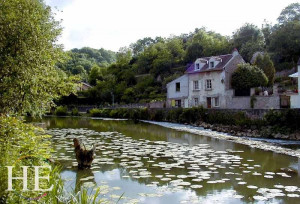
Today’s route is short, only about 25 miles, but with three hills, you may consider it the most challenging day of the trip. Don’t be scared off by these hills: they’re a good incentive to do some advanced training, but even if you walked up each one, you’d have time left for sightseeing. And plenty of spots to do it. Experienced cyclists often rank this as their favorite biking day of the trip.
Our first village is Flavigny, a fortified town from the Middle Ages with the ruins of a seventh-century abbey. Lose yourself amongst the old ramparts and narrow lanes of this attractive town. Many Flavigny homes date from the Middle Ages and have been recently restored. Pick up a locally-produced snack of anise candy at the outdoor market. And if the village looks familiar, it may be because you saw the movie Chocolat, which was filmed here.
Then roll on to tiny Hauteroche — and a lunch to remember. For much of the French population, lunch rather than dinner is the big meal of the day, and every French town has at least one cafe where the locals come day after day for refueling. We walk into Chez Jeannette aka Cafe des Roches. For a ridiculously low price, we get — well, a ridiculously large lunch, as well as a good-natured scolding from Jeannette for anyone who doesn’t clean their plate.
As we leave this tiny village, you can still see foundations of Roman homes that stood here almost 2,000 years ago.
Toward the end of the day comes a popular option that nearly everyone takes: cycling to the source of the River Seine. In a quiet park maintained by the city of Paris, you can step across the river that is the heartbeat of France’s capital.
Our home for the night is a small lodge in the hamlet of St. Seine l’Abbaye, where we’ll sleep just a few doors down from a 13th-century church.
Day 6: A Madame of the Old School
Today’s official route is short, allowing plenty of time to explore the intriguing region between here and Gevrey-Chambertin.
Shortly before lunch, we pass through Malain, whose hilltop castle ruins are undergoing restoration. Perched high over the valley, the castle ruins offer sweeping views of the cinnamon-tiled roofs below.
Toward the end of today’s route, we cross through dramatic canyonland. A scenic option, sweeping through the forests to the south, takes you within an easy walking distance of ancient menhirs, arrangements of stone set in place by primitive settlers. Then, on a larger road, we follow a narrow cliff-lined gorge that finally spills into Gevrey-Chambertin, a town famous for its red wine.
The castle that once protected Gevrey-Chambertin remains still in family hands, and open to the public. We’ll have time this afternoon to visit. If we’re lucky, we’ll get a tour from the owner herself, an elderly Frenchwoman of the old school who’s still angry about the French Revolution. For that matter, she hasn’t entirely forgiven the Roman invasion, either.
Day 7: In the Heart of the Wine Country
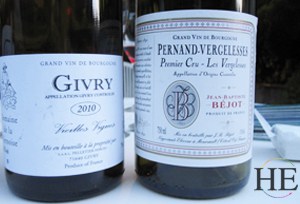
It’s an easy but scenic trip back to Beaune, through several more noted wine towns: Chambolle-Musigny, Vosne-Romanee, and Nuits St. George. Take time to look around each of these charming and ancient villages. Or loop up into the hills, and enjoy a picnic lunch in a small copse overlooking the vineyards.
You’ll arrive in Beaune early enough for sightseeing. Don’t miss the Hotel Dieu, Beaune’s masterpiece of Burgundian architecture, whose colorfully tiled roof has graced the cover of many a guidebook.
Those who aren’t ready to turn in their cycling shorts yet can continue on to the chateau at Rochepot and more unspoiled villages with names long familiar to wine connoisseurs: St. Aubin, Gamay, Chassagne-Montrachet, Puligny-Montrachet, and Meursault.
Day 8: Departure
The hardest thing about our trips is saying goodbye to a wonderful group of new friends, and a charming region of France.
If you’ve got extra vacation time in Europe, we suggest you save it for after the trip, rather than before: Chances are, there will be other cyclists from this week’s adventure who would like some company for a weekend in Paris.
Price Includes
Price includes: Comfortable hotels each night; Services of two tour guides; All breakfasts, 3 lunches, and 4 dinners with wine included; Transportation to get luggage (and tired riders!) to the destination; Use of a bike; Two wine-tastings; Map, guidebook, and routes. HE Travel provides complimentary Medical & Evacuation Insurance for every US Resident on our group tours who does not have other coverage.
Not included: Transportation to and from starting location; 3 lunches; 3 dinners; Souvenirs, snacks, admissions Gratuities for guides.
Extensions
When you travel Back to Back on two of our tours, you’re eligible for a discount. Contact us for details!
Arrive early and Bicycle the Loire Valley
For those with more time to spend in France, consider coming early and joining our Valley of the Chateaux tour! For 200 years, the kings of France outdid one another as they built palaces along the Loire Valley. Bicycle to Amboise, Chenonceau (where gay Henri III held drag parties), and Azay-le-Rideau. Our gay French bike tours are the perfect way to travel between the castles of France.
Tour Insurance
We strongly recommend the purchase of Trip Cancellation and Interruption insurance to protect your vacation investment in case of unforeseen circumstances such as flight delay, illness, or injury. Click Here to learn more about our Insurance partner.

